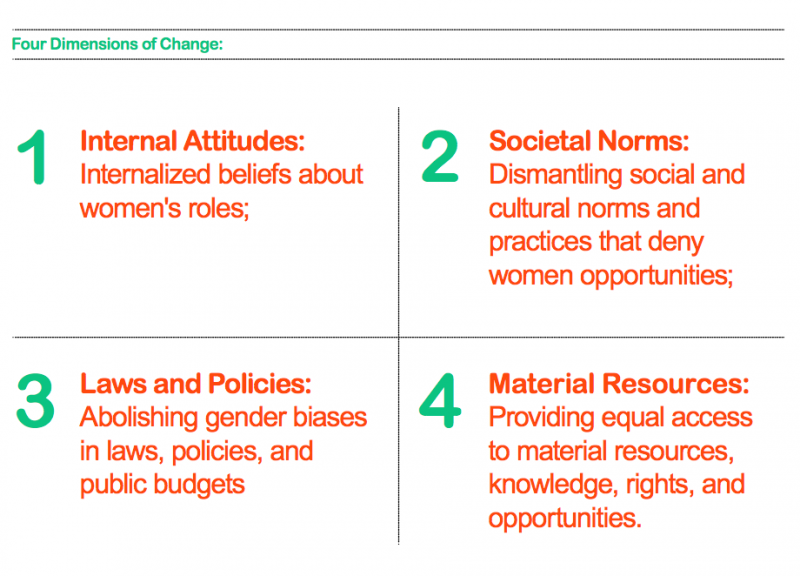Women and girls are in the public eye, recognized as key agents in development, like never before. Yet this increased interest is not translating into resources for the very organizations that are key to creating sustained systematic change in the lives of women and girls, as a new animation video from AWID shows.
Since 2005, AWID has been asking the question ‘Where is the Money for Women’s Rights?’. Consistently, the answer we have found is that there is very limited funding available for the transformative, long-term, and political work of women’s rights organizations. Most recently, in New Actors, New Money, New Conversations, we explored the current landscape of the corporate sector and other actors new to supporting women and girls and the role they are playing in shaping funding discourse and practice.
Over the past five years, the corporate sector as funder and a relatively new actor in women’s rights has launched programs and pledged large amounts of money for the empowerment of women and girls. AWID estimates that USD 14.6 billion has been pledged by the private sector to support programs involving girls and women through 2005 and 2020. Yet, despite being new to engaging with issues affecting women and girls, only 27% of these programs actually engage women’s rights organisations as partners; and only 9% directly fund grassroots organisations. In fact, less than one percent of women’s rights organisations actually receive direct funding from corporate funders.[1]
These figures make clear the disconnect between the private sector’s investments in women and girls, and the social change efforts being led by women’s rights organisations. Racheal Meiers, the Director of Inclusive Economy at Business for Social Responsibility (BSR), notes that, “most corporate investments today focus on the “economic empowerment” of women exclusively, without examining or investing in other aspects of empowerment, such as legal rights, harmful norms and practices, or women’s leadership. And those investments tend to focus on building individual empowerment, rather than on tackling systemic barriers to gender equality.”
What really works in the struggle to improve the lives of women and girls around the world?
Women’s rights organisations for years have been working to create lasting change by addressing the multiple dimensions of inequalities and injustice. Four key dimensions of change necessary to advancing women’s rights were were first articulated by Gender at Work.

Adapted by Srilatha Batliwala from the Gender at Work matrix first articulated by Aruna Rao and David Kelleher. “Is there Life After Mainstreaming?” in Gender and Development: Mainstreaming – A Critical Review, 13.2 Oxfam UK (July 2005)
Recent research conducted by Dalberg, The International Centre for Research on Women (ICRW), The Oak Foundation, and Assemblyfor, shows that the best way for new donors, including the new corporate actors, to support women and girls is through this multidimensional ‘integrated’ human rights-based approach. An integrated approach in funding accounts for the underlying structural and social barriers to equality, rather than funding only the symptoms of systemic problems. It sees women and girls as active agents of change instead of passive recipients of support, and addresses the four different dimensions of change.
Economic empowerment, a common focus of funding by new donors, is vital to improving the lives of girls and women. Girls living in poor households are almost twice as likely to marry before the age of 18 as girls in higher-income households, and intimate partner violence is more frequent and more severe amongst poorer groups.
Yet without an integrated approach, even the best women’s economic empowerment programs may not succeed due to systemic challenges that make economic empowerment incomplete. Discriminatory laws and legal systems, lack of control over household resources, early marriage, violence, and discrimination within families and communities, and lack of access to financial institutions continue to hold women and girls back. Women’s economic empowerment is also hindered by women not being able to make their own reproductive decisions, or by limited access to comprehensive and quality health services throughout their lives.
While the impact of investing in an individual, also a focus of some new donor programs, may feel more tangible, this overlooks systemic factors beyond the individual’s control that can ultimately affect the success of investing in an individual in the long term. Providing a young woman with a scholarship, for example, is only effective if her community’s laws and cultural practices make it possible for her to study the subject of her choice or find a job after graduating.
The Role of Women’s Rights Organisations
Women’s rights organisations have decades of experience with grassroots networks working for sustainable change. They have learned that achieving long lasting change takes long-term integrated strategies.
Moreover, women’s rights organisations have also driven changes in areas that were previously seen as ‘private’ or ‘cultural’ matters, including around violence against women, and sexual and reproductive health and rights.
Women’s rights organisations have vital expertise and knowledge to share about what works in complex political, and cultural settings.
Some private sector donors are beginning to recognize the value of an integrated approach and the key role that women’s rights organizations play in creating long lasting change, and are advocating that others adopt it. Daniel Lee, Executive Director of the Levi Strauss Foundation notes: “women’s organizations have been drivers of some of the most important changes in our lifetimes, with repercussions in every sphere and corner of the globe. And there’s a win-win opportunity here with real mutual value, but up until now private sector players are missing out.”
Now is the time for both new and longstanding donors to work with women’s rights organisations, in providing funds and designing programs that enable lasting, systematic change for women and girls.
2224x1253.jpg)